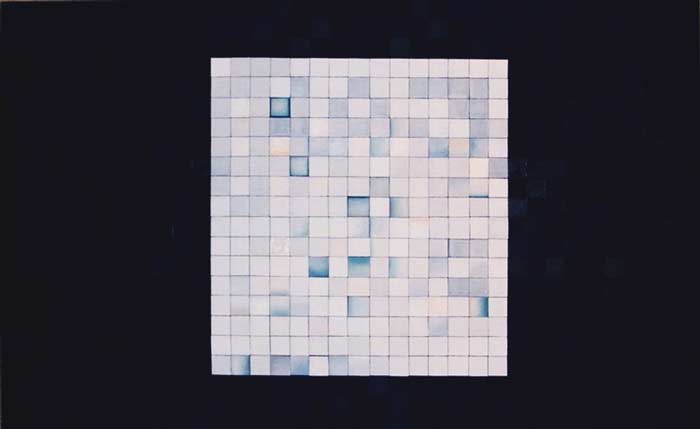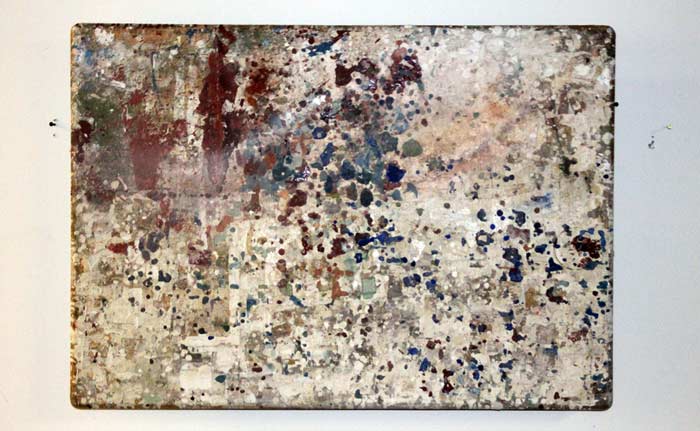A white square on a tyrannical grid cannot quite shake off the blue imposing on its borders. The dark blue, nearly black, cannot quite achieve an even opacity. The grid is merciless. The painting is defined entirely by lines, but it is the spillover that tells the story.

Odysseus and Tlaloc Reconsider Reality
“To tell a story without imagery is more powerful than to tell a story with imagery,” hints the work’s creator, Luis DeLaTorre. Indeed, this story could not be told otherwise. Inching closer to the canvas, I’m suddenly enjoying the novelty of being comfortable inside a concept that has until now eluded me. The difference between minimalism and abstract, between pompous artistic bullshit and real meaning, reifies like a chair I can sit in. I prefer to believe that what I’m looking at isn’t an impression of anything. It is an exact portrait of an existential reality. Life, as we live it, resides in shades of gray between two superlatives. The concept depicted here is superlative. And when DeLaTorre explained it just for a second, I could see why he was so eager to cross the room to admire this proud recent creation. The square is perfect. Its limits are perfect. The communication is real. The image, which is not among DeLaTorre’s most technically demanding pieces, is a bird’s eye view of existence itself. It is about the stages of existence and non-existence. The negative space is not entirely negative, and the positive is not entirely white. There are definite limits to our existence, as defined by the unforgiving lines of the positive square. Still, when we ponder the nature of our non-existence, we project life into the non-existence and invite a tiny bit of death into our lives. It is about what we choose to let in.
That an artist trusts such profundity with the viewer is not uncommon. What distinguishes Luis DeLaTorre from his peers is the diversity of styles from which he broaches his topics. His mastery of realism lends depth to his minimalism. Humanity Takes a Time Out, for example, is a classic iconographic narrative with loaded imagery: a battleship, a bleeding Aztec temple and an anthropic sea monster. At this point in his career, however, DeLaTorre wants to move away from that. One of the pieces he is most proud of is a small slab of wood smoothed over with nothing but a layer of dark gesso paint. For him, it represented a moment when he felt he was able to fully let go and not try to show anything.
Combined with the paintings adorning the walls of his Bridgeport studio and display space, DeLaTorre’s little minimalist triumph does show something. The diversity and quality of the radically different styles in his collection show that he not only has near-mastery of a number of techniques, but that he is comfortable abandoning his technical skill in order to fully give himself over to the evolution of his aesthetics. A few years ago, DeLaTorre experimented with sleep deprivation exercises. Though he gave up the practice due to health concerns, his work was transformed. “What I did learn from these exercises is that by allowing myself to let go when I am working, my work becomes very meditative and through this meditation I begin to get into my direct stream of consciousness,” said DeLaTorre. Thus commenced a fascination with the “process” of creating a work.
DeLaTorre’s narrative pieces are evocative and meaningful, but they were created with less regard for the act of creation than for attaining a predetermined end. By more intimately connecting his subconscious with his work, he realized that he had the ability to relate concepts more powerfully than his previous use of imagery had: “My goal is to create directly from this meditative state to give viewers a sense of the image without really using the image.” The goal, he explained, is to allow maximum room for interpretation.
His minimalist works certainly achieve that. But when is room too much room? Odysseus and Tlaloc Reconsider Reality, for example, conveys an ineffable concept in a brilliant way—once it’s explained. DeLaTorre has an untitled piece hanging nearby that is much more densely painted and textured. DeLaTorre likes the fact that approaching it new, one could not tell what exactly it means, or the extraordinary amount of time that went into its creation. As it turns out, this one has no conceptual driver, but it did take a long time to create: it’s his old work table. Revealing that fact was a nasty trick to play on someone who had just gotten used to sitting in a newfound appreciation of abstract art like a chair. But DeLaTorre never pretends it’s anything but a philosophic look at “process.” The point is that if it draws out something in the viewer’s mind, it still serves as a kind of reflection.

Art?
DeLaTorre embraces many styles of painting for this very reason. “It isn’t really the medium that drives the work, it’s the creative concept. Everything else is merely a means to produce that concept.” Meaning resides in the work to the artist because they made it. By definition it is self-expression to some degree. The challenge is evoking self-expression in the mind of an unattached viewer. DeLaTorre believes that showing less unclutters the work, like cleaning a mirror.
At least, he does now. Luis DeLaTorre is a quickly darting creative force, and his style has changed rapidly over his career. Even his titles convey constant motion. His subjects are often “going for a drive,” “unleashing,” or “eavesdropping.” His career is similarly energetic. In a testament to his diversity of skills, DeLaTorre does restoration work for old buildings, accepts mammoth mural commissions, and volunteers as an art educator at the same time as he works on two or three personal projects in his studio. Things are hectic in his world. For now, he’s trying to create the opposite of that on his canvases.
http://www.delatorrearts.com/
http://delatorrearts.blogspot.com/